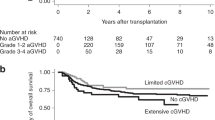Abstract
In comparison to bone marrow, umbilical cord blood has decreased intrinsic immune responsiveness allowing transplantation across HLA barriers with lower rates of graft-versus-host disease. However, laboratory models have also suggested that cord blood may be extremely sensitive to stimulation by cytokines. We report an adult recipient of an ex vivo expanded, HLA-mismatched, unrelated cord blood transplant who experienced a late extramedullary relapse while still in hematologic remission. Despite demonstrating immune tolerance on minimal immunosuppressive agents, a brief course of intravenous interleukin-2 resulted in rapid, aggressive graft-versus-host and graft-versus-leukemia reactions. This case highlights the potential of cytokine immunomodulation following cord blood transplantation, but also suggests caution in stimulating these cells. Bone Marrow Transplantation (2000) 26, 353–355.
This is a preview of subscription content, access via your institution
Access options
Subscribe to this journal
Receive 12 print issues and online access
$259.00 per year
only $21.58 per issue
Buy this article
- Purchase on Springer Link
- Instant access to full article PDF
Prices may be subject to local taxes which are calculated during checkout
Similar content being viewed by others
References
Kurtzburg J, Laughlin M, Graham ML et al. Placental blood as a source of hematopoietic stem cells for transplantation into unrelated recipients New Engl J Med 1996 335: 157–166
Gluckman E, Rocha V, Boyer-Chammard A et al. Outcome of cord-blood transplantation from related and unrelated donors New Engl J Med 1997 337: 373–381
Broxmeyer HE, Smith FO . Cord blood stem cell transplantation. In: Thomas ED, Blume KG, Forman SJ (eds) Hematopoietic Cell Transplantation Blackwell Science: Malden, MA 1999 431–443
de Le Selle V, Gluckman E, Bruley-Rosset M . Graft-versus-host disease and graft-versus-leukemia effect in mice grafted with peripheral newborn blood Blood 1998 92: 3968–3975
Joshi SS, Babushkina-Patz MN, Verbik DJ et al. Antitumor activity of human umbilical cord blood cells: a comparative analysis with peripheral blood and bone marrow cells IntJ Oncol 1998 13: 791–799
Barbey C, Irion O, Helg C et al. Characterisation of the cytotoxic alloresponse of cord blood Bone Marrow Transplant 1998 22: (Suppl. 1) S26–S30
Goodman M, Cabral L, Cassileth P . Interleukin-2 and leukemia Leukemia 1998 12: 1671–1675
Slavin S, Naparstek E, Nagler A et al. Allogeneic cell therapy with donor peripheral blood cells and recombinant human interleukin-2 to treat leukemia relapse after allogeneic bone marrow transplantation Blood 1996 87: 2195–2204
Robinson N, Sanders JE, Benyunes MC et al. Phase I trial of interleukin-2 after unmodified HLA-matched sibling bone marrow transplantation for children with acute leukemia Blood 1996 87: 1249–1254
Massumoto C, Benyunes MC, Sale G et al. Close simulation of acute graft-versus-host disease by interleukin-2 administered after autologous bone marrow transplantation for hematologic malignancy Bone Marrow Transplant 1996 17: 351–356
Meloni G, Vignetti M, Pogliani E et al. Interleukin-2 therapy in relapsed acute myelogenous leukemia Cancer J Sci Am 1997 3: S43–S47
Blaise D, Attal M, Pico JL et al. The use of a sequential high dose recombinant interleukin-2 regimen after autologous bone marrow transplantation does not improve the disease free survival of patients with acute leukemia transplanted in first complete remission Leuk Lymphoma 1997 25: 469–478
Fefer A, Robinson N, Benyunes M et al. Interleukin-2 therapy after bone marrow or stem cell transplantation for hematologic malignancies Cancer J Sci Am 1997 3: S48–S53
Hoshina T, Kida K, Ito M . Differences in response of NK cell activity in newborns and adults to IL-2, IL-12, and IL-15 Microbiol Immunol 1999 43: 161–166
Gaddy J, Broxmeyer HE . Cord blood natural killer cells: implications for cord blood transplantation and insights into natural killer cell differentiation. In: Broxmeyer HE (ed) Cellular Characteristics of Cord Blood and Cord Blood Transplantation AABB Press: Bethesda 1998 83–111
Gardiner CM, Meara AO, Reen DJ . Differential cytotoxicity of cord and bone marrow-derived natural killer cells Blood 1998 91: 207–213
Soiffer RJ, Murray C, Gorin R, Ritz J . Effect of low-dose interleukin-2 on disease relapse after T-cell-depleted allogeneic bone marrow transplantation Blood 1994 84: 964–971
Author information
Authors and Affiliations
Rights and permissions
About this article
Cite this article
Goldberg, S., Pecora, A., Rosenbluth, R. et al. Treatment of leukemic relapse following unrelated umbilical cord blood transplantation with interleukin-2: potential for augmenting graft-versus-leukemia and graft-versus-host effects with cytokines. Bone Marrow Transplant 26, 353–355 (2000). https://doi.org/10.1038/sj.bmt.1702520
Received:
Accepted:
Published:
Issue Date:
DOI: https://doi.org/10.1038/sj.bmt.1702520
Keywords
This article is cited by
-
Unrelated donor umbilical cord blood transplantation in adults
Leukemia (2002)



